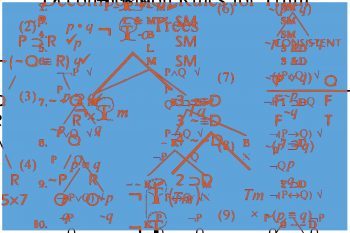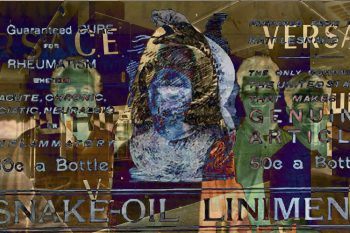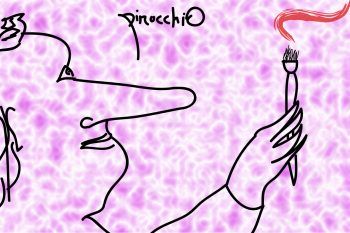by Nickolas Calabrese
 When one makes an artwork, something flows from artist to audience. The thing flowing is actually several: concepts, ideas, aesthetic experiences, duration itself, beliefs, attitudes, and probably much more. Artworks work in a similar way to language, although it would be foolish to believe that artworks are language. Their similarities to language end at the transmission from one to another of the things flowing. That’s how language works as well. But for art, as with something like emotion, the flow is vague in how it is sent and received. It seems to me that the best linguistic analogy for what artworks do is located in assertion. Artworks assert a position. Of course it is entirely possible, and even the norm, that their version of assertion is cryptic to the point of being sometimes unintelligible. But assertions don’t need to be crystal clear. One can assert their dominance over another through a series of non-linguistic subtle bodily movements. Likewise, artworks can make assertions through their physical presence.
When one makes an artwork, something flows from artist to audience. The thing flowing is actually several: concepts, ideas, aesthetic experiences, duration itself, beliefs, attitudes, and probably much more. Artworks work in a similar way to language, although it would be foolish to believe that artworks are language. Their similarities to language end at the transmission from one to another of the things flowing. That’s how language works as well. But for art, as with something like emotion, the flow is vague in how it is sent and received. It seems to me that the best linguistic analogy for what artworks do is located in assertion. Artworks assert a position. Of course it is entirely possible, and even the norm, that their version of assertion is cryptic to the point of being sometimes unintelligible. But assertions don’t need to be crystal clear. One can assert their dominance over another through a series of non-linguistic subtle bodily movements. Likewise, artworks can make assertions through their physical presence.
Formally, an artwork is perched somewhere, on the floor or the wall, installed somewhere in a public park, and so on. The physical position is exceptionally important to the artist. The way the artwork sits is, or should be, crucial to how the artist wants the piece to function. It has an attitude. If we are again to follow the metaphor using language, we could say that an artwork is a propositional attitude, such that it contains the beliefs or disbeliefs of the artist, the series of mental states that amount to this singular crystallization of an artist’s thought. That the work does this duty is critical, otherwise it says nothing and does nothing, and then, what’s the point of making anything at all? No, an artwork has a job to do in the world.
Making assertions is a funny thing for an artwork to do. Funny because they are obviously non-verbal (unless of course there is an audio element of speaking). So how does the assertion take place? Well an assertion can be vague too, like someone asserting that cheddar cheese is superior to gouda cheese. The assertion ought to have an element of truth, but it is not clear based on an assertion such as “cheddar is superior to gouda” that this is actually true. Think of artworks in a similar way. They are making assertions, but the truth or relevance of their assertions might be murky. Suppose if somebody asserted “cheddar cheese is naughty”, now this assertion, beyond the question of truth, is almost unintelligible because the adjective does not have a clear relationship to the subject. If there were to be a conclusion drawn from this assertion, it would certainly be fallacious. The way that artworks assert, based on their silence and their disruptive form (meaning only that artworks only come into existence when the artist wills them, and as such they have never existed before, so formally they are a new addition to the world of things, and hence “disruptive”), is vague.
Thinking about artworks as having an assertive propositional attitude would bring up the 20th century philosophical question of direction of fit. Direction of fit is the terminology used to describe how the mind and the world match up to make sense. So there are standardly two directions of fit: 1) from the mind or the word to the world, and 2) from the world to the mind or the word. In the former, the person forms thoughts or sentences that must fit into the way that the world is, and in the latter, the world must accommodate the thoughts or the words that a person thinks or utters. This terminology was first coined by J.L. Austin in his short essay “How to Talk: Some Simple Ways”. In it he describes the direction of fit as the difference “between fitting a name to an item (or an item with the name) and fitting an item to a name (or a name with the item). These differ as fitting a nut with a bolt differs from fitting a bolt to a nut.” He was stressing the causal linguistic connections that words have with the world, as much of his work was attempting to do. But a better, and supposedly the first, description of direction of fit is found in G.E.M. Anscombe’s seminal work Intention:
32. Let us consider a man going round a town with a shopping list in his hand. Now it is clear that the relation of this list to the things he actually buys is one and the same whether his wife gave him the list or it is his own list; and that there is a different relation when a list is made by a detective following him about. If he made the list itself, it was an expression of intention; if his wife gave it to him, it has the role of an order. What then is the identical relation to what happens, in the order and the intention, which is not shared by the record? It is precisely this: if the list and the things that the man actually buys do not agree, and if this and this alone constitutes a mistake, then the mistake is not in the list but in the man’s performance (if his wife were to say: ‘Look, it says butter and you have bought margarine’, he would hardly reply: ‘What a mistake! We must put that right’ and alter the word on the list to ‘margarine’); whereas if the detective’s record and what the man actually buys do not agree, then the mistake is in the record.
The detective following the man is responsible for making a list that conforms to how the world actually is. His is a record of the state of things in the world. The man’s list however, is causing the world to conform to it. So the man’s list is the true state of affairs, and if the items don’t make it into his cart then the world has erred. If the detective’s list is wrong, then it is the detective who has erred. Direction of fit is an important concept because it examines how different forms of speech (speech acts) have different relationships with the world. For instance, predictions would be word to world, and commands would be world to word. Other writers, like John Searle, have pointed out that there can be a null direction of fit, such that a phrase like “thank you”, while still being a speech act, does not have either direction.
 Do artworks have a direction of fit? Is it work-to-world, world-to work, or is it a null relationship? Because of what I’ve said above, that artworks can be best viewed as assertions, I do think that they can have a direction of fit, and, in the best case, that it’s artwork-to-world. Given that artworks assert positions, values, meanings, and so on, it seems reasonable to make the claim that they work based on an understanding of how the world already is. If an artwork “has something to say” about incarceration in America, then it is making an assertion about the way the world is, and conforming its language to that. The world is not changing to accommodate the artwork, but the artwork is positioning itself as describing something about the world in some way.
Do artworks have a direction of fit? Is it work-to-world, world-to work, or is it a null relationship? Because of what I’ve said above, that artworks can be best viewed as assertions, I do think that they can have a direction of fit, and, in the best case, that it’s artwork-to-world. Given that artworks assert positions, values, meanings, and so on, it seems reasonable to make the claim that they work based on an understanding of how the world already is. If an artwork “has something to say” about incarceration in America, then it is making an assertion about the way the world is, and conforming its language to that. The world is not changing to accommodate the artwork, but the artwork is positioning itself as describing something about the world in some way.
Now there is a problem with all of this. Direction of fit carries with it, necessarily, the fact that beliefs or the words, or the artworks in our present case, aim to be true, and so the direction of fit is what might prove veracity. It is quite uncommon to hear of an artwork described using the language of “true” or “false”, and I’m not sure if that’s even possible to assign truth values to artworks. Has anyone ever looked at Mike Kelley’s Educational Complex and said, “this artwork is true”? It’s doubtful. Why would they? The problem is precisely here: can an artwork be true or false, and does it matter? It appears to matter insofar as our metaphor of art and language are concerned, because assertions can usually be proven true, especially when coupled with the idea of direction of fit.
I want to offer a few suggestions about the question of whether or not art can be, strictly speaking, true. It would be possible if all of the elements of some given artwork could be quantified into a notational system that corresponds to real world values. I think this is possible, but will probably never happen for any artwork. The reason for that is various, but the most relevant one is that artworks contain aspects that are impenetrable even to the artist themselves. Countless times I’ve received the answer of “I don’t know” when posing the question of “Why did you do this?” to an artist. And that is not some coy or cunning way of skirting a question; it is a legitimate response to a question they cannot answer, because of some unwitting subconscious collaboration in their own mind when making the thing in question. Producing art is never a holistic process. There are moments when a decision is made based on pure impulse, and that impulse is extraordinarily difficult to introspect in a meaningful way. It would seem obvious that we cannot expect truth values as a result of subconscious or unconscious decision making in normal conditions. But it still ought to be possible if one spent enough time enumerating all of the decisions that went into making the thing.
 Furthermore, if direction of fit is proven in an artwork – that artworks are shaped by the way the world is – then there is little reason to attempt to prove an artwork true or false. We can try to prove them more or less true, but they always exist closer to the realm of faith. That is, we take it on faith that an artist is not trying to cheat us. There’s the classic example of an older non-arts-oriented person looking at a Pollock painting saying, “my kid could’ve done that.” The idea when people utter this sentiment is that they feel cheated by the artist. Cheated because they know that this thing costs millions of dollars, and they paid a $25 entry fee at the museum to see it. They think the work is a farce. But if we discount that opinion as simply one that displays a lack of familiarity and knowledge about the subject, then we can move to the question of faith again.
Furthermore, if direction of fit is proven in an artwork – that artworks are shaped by the way the world is – then there is little reason to attempt to prove an artwork true or false. We can try to prove them more or less true, but they always exist closer to the realm of faith. That is, we take it on faith that an artist is not trying to cheat us. There’s the classic example of an older non-arts-oriented person looking at a Pollock painting saying, “my kid could’ve done that.” The idea when people utter this sentiment is that they feel cheated by the artist. Cheated because they know that this thing costs millions of dollars, and they paid a $25 entry fee at the museum to see it. They think the work is a farce. But if we discount that opinion as simply one that displays a lack of familiarity and knowledge about the subject, then we can move to the question of faith again.
We take it on faith that the artwork will be an artist’s closest approximation to the truth. Sure there are artists who I believe are doing what amounts to telling lies, but hopefully most do not. And that is what I think is most important: that an artist is engaged in producing what they believe to be the closest approximation to the truth in a system that is unlikely to produce concrete results on a truth tree. The closest approximation is what we usually get in normal life too. It’s not often that people defer to systematic logic to deduce whether or not someone’s assertion is true. We usually just shrug and say “ok, I believe you”, unless it’s unusually important. The truth is a fickle rat to catch. And truth in art is an even fickler one, but that’s ok. At the end of the day it is pleasure that we seek from artworks anyway – truth is just assumed.
